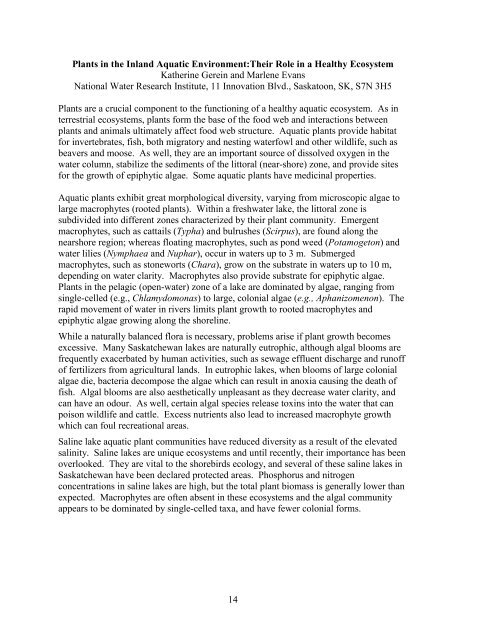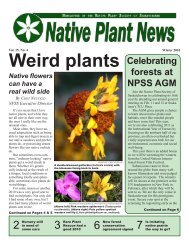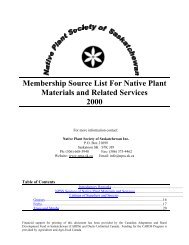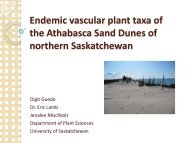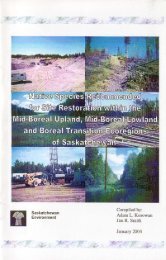Native Plants As Habitat For Wildlife - Native Plant Society of ...
Native Plants As Habitat For Wildlife - Native Plant Society of ...
Native Plants As Habitat For Wildlife - Native Plant Society of ...
You also want an ePaper? Increase the reach of your titles
YUMPU automatically turns print PDFs into web optimized ePapers that Google loves.
<strong><strong>Plant</strong>s</strong> in the Inland Aquatic Environment:Their Role in a Healthy Ecosystem<br />
Katherine Gerein and Marlene Evans<br />
National Water Research Institute, 11 Innovation Blvd., Saskatoon, SK, S7N 3H5<br />
<strong><strong>Plant</strong>s</strong> are a crucial component to the functioning <strong>of</strong> a healthy aquatic ecosystem. <strong>As</strong> in<br />
terrestrial ecosystems, plants form the base <strong>of</strong> the food web and interactions between<br />
plants and animals ultimately affect food web structure. Aquatic plants provide habitat<br />
for invertebrates, fish, both migratory and nesting waterfowl and other wildlife, such as<br />
beavers and moose. <strong>As</strong> well, they are an important source <strong>of</strong> dissolved oxygen in the<br />
water column, stabilize the sediments <strong>of</strong> the littoral (near-shore) zone, and provide sites<br />
for the growth <strong>of</strong> epiphytic algae. Some aquatic plants have medicinal properties.<br />
Aquatic plants exhibit great morphological diversity, varying from microscopic algae to<br />
large macrophytes (rooted plants). Within a freshwater lake, the littoral zone is<br />
subdivided into different zones characterized by their plant community. Emergent<br />
macrophytes, such as cattails (Typha) and bulrushes (Scirpus), are found along the<br />
nearshore region; whereas floating macrophytes, such as pond weed (Potamogeton) and<br />
water lilies (Nymphaea and Nuphar), occur in waters up to 3 m. Submerged<br />
macrophytes, such as stoneworts (Chara), grow on the substrate in waters up to 10 m,<br />
depending on water clarity. Macrophytes also provide substrate for epiphytic algae.<br />
<strong><strong>Plant</strong>s</strong> in the pelagic (open-water) zone <strong>of</strong> a lake are dominated by algae, ranging from<br />
single-celled (e.g., Chlamydomonas) to large, colonial algae (e.g., Aphanizomenon). The<br />
rapid movement <strong>of</strong> water in rivers limits plant growth to rooted macrophytes and<br />
epiphytic algae growing along the shoreline.<br />
While a naturally balanced flora is necessary, problems arise if plant growth becomes<br />
excessive. Many Saskatchewan lakes are naturally eutrophic, although algal blooms are<br />
frequently exacerbated by human activities, such as sewage effluent discharge and run<strong>of</strong>f<br />
<strong>of</strong> fertilizers from agricultural lands. In eutrophic lakes, when blooms <strong>of</strong> large colonial<br />
algae die, bacteria decompose the algae which can result in anoxia causing the death <strong>of</strong><br />
fish. Algal blooms are also aesthetically unpleasant as they decrease water clarity, and<br />
can have an odour. <strong>As</strong> well, certain algal species release toxins into the water that can<br />
poison wildlife and cattle. Excess nutrients also lead to increased macrophyte growth<br />
which can foul recreational areas.<br />
Saline lake aquatic plant communities have reduced diversity as a result <strong>of</strong> the elevated<br />
salinity. Saline lakes are unique ecosystems and until recently, their importance has been<br />
overlooked. They are vital to the shorebirds ecology, and several <strong>of</strong> these saline lakes in<br />
Saskatchewan have been declared protected areas. Phosphorus and nitrogen<br />
concentrations in saline lakes are high, but the total plant biomass is generally lower than<br />
expected. Macrophytes are <strong>of</strong>ten absent in these ecosystems and the algal community<br />
appears to be dominated by single-celled taxa, and have fewer colonial forms.<br />
14


